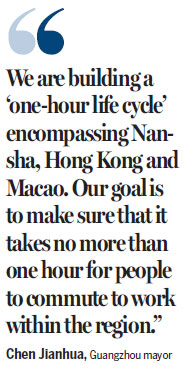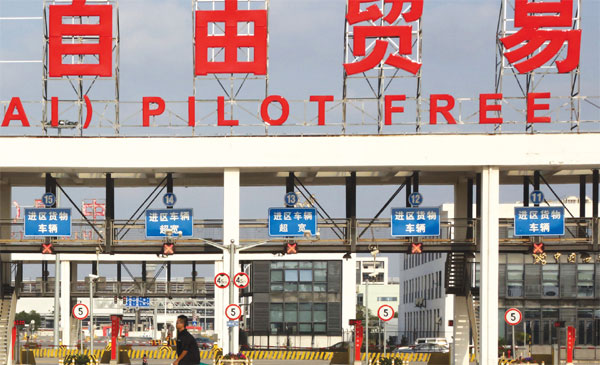All eyes on Nansha as FTZ takes off
Updated: 2015-04-22 07:07
By Yang Ziman(HK Edition)
|
|||||||
|
Guangdong's replica of the Shanghai free trade zone would further intertwine links among cities in the Pearl River Delta region and breathe new life into the local economy. Tomohiro Ohsumi / Bloomberg |
Guangzhou zone to be key link as huge infrastructure network takes shape
In two years' time, it will take only half an hour to travel from Nansha - a coastal region of Guangzhou at the estuary of the Pearl River - to Hong Kong and Macao as the area builds up its massive transportation and infrastructure network following its inclusion in the new Guangdong Free Trade Zone (FTZ), which officially came into being on Tuesday.
Nansha is the largest of three districts covered in the province's FTZ - the others being Shenzhen's Qianhai special economic zone and Zhuhai's Hengqin Island, which form a triangle surrounding the Pearl River estuary.
Nansha has been designated as a showcase area for comprehensive collaboration among Guangdong, Hong Kong and Macao, with some 800 enterprises having been set up there with Hong Kong and Macao investments totaling $13.84 billion. Following the FTZ's approval by the central government last year, a further 120 Hong Kong and Macao companies, including 106 from the services, navigation logistics, science, tourism and health sectors, have settled down in Nansha.
"In the next few years, the biggest investment in Nansha will be transportation infrastructure," said Guangzhou Mayor Chen Jianhua.
"We are building a 'one-hour life cycle' encompassing Nansha, Hong Kong and Macao. Our goal is to make sure that it takes no more than one hour for people to commute to work within the region. They can leave their home in the morning and be back in the evening."

Nansha aims to build 28 rail transit routes and eight express ways as part of its ambitious transportation and infrastructure expansion program.
"The positioning of Nansha as part of the Guangdong FTZ is that it will be built into the central business district in the Pearl River Delta Region, linking the Guangdong hinterland, Hong Kong and Macao," said Wang Wei, chief planner of the Nansha office of the Guangzhou City Planning Bureau.
So far, 120 kilometers of a 200-kilometer expressway in Nansha have been completed, including the expressway surrounding Guangzhou, that connecting Beijing, Hong Kong and Macao, and the highway-and-railway bridge linking Shenzhen and Maoming.
Hengqin Island, with an area three times the size of Macao, has transformed itself from a sleepy fishing village into a busy center connecting the mainland, Macao and Hong Kong after it became a new development zone in 2009.
"The central government's goal for the strategic development of Hengqin is that it should function as an extension of Hong Kong and Macao," said Ye Zhen, deputy Party chief of the management commission of Hengqin.

"Unlike traditional urban development, Hengqin is not aiming at high GDP growth," he said. "Instead, we're focusing on high value-added sectors like tourism, services, and the innovative and cultural industries."
More than 60 projects, with a total investment of 240 billion yuan ($38.7 billion), have taken off on Hengqin, including a 1.5-million-square-meter cultural complex operated by Hong Kong-based Lai Sun Group costing 18 billion yuan. The facility will house entertainment, movie-production and video-game companies as well as grand theaters, art auction houses and hotels.
Due to its proximity to Macao, Hengqin has attracted a wide range of companies from the Special Administrative Region. As of the end of last year, 213 Macao firms had set up shop there.
Hengqin has introduced a mechanism for young entrepreneurs from Macao, offering offices at lower-than-market prices to companies in an area dedicated to startups covering 140,000 square meters. Moreover, an entrepreneurial fund of 2 billion yuan has been launched to help young businessmen from Macao.
Xu Minghua, executive board chairman of Shenzhen Minghua Xinde Asset Management Ltd, said the biggest challenge facing startup companies is the lack of land.
"Hengqin offers office rents averaging 3,000 yuan per square meter. In Macao, it's 27,000 yuan per square meter, nine times of that of Hengqin. Besides, there are not than many choices in Macao, except gambling. Therefore, the relatively large space on Hengqin will offer more opportunities for Macao to diversify its economy," Xu noted.
Other large-scale projects, such as a traditional Chinese-medicine industrial park, medical centers and entertainment facilities, are expected to attract more enterprises and visitors to the island.
yangziman@chinadaily.com.cn
(HK Edition 04/22/2015 page9)
